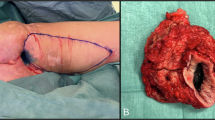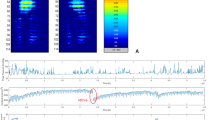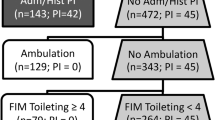Abstract
Study design
Systematic review and meta-analysis.
Objectives
To identify, critically appraise, and synthesize research findings on non-sensate versus sensate flaps among individuals with spinal cord disease and pelvic pressure ulcers, with pressure ulcer recurrence as primary outcome.
Methods
PubMed, EMBASE, and Cochrane CENTRAL were screened for relevant studies. Data on surgical characteristics, ulcer recurrence, and sensory outcomes were retrieved and tabulated. Risk of bias was assessed with MINORS. The level of evidence was evaluated with GRADE. Meta-analysis was performed when possible.
Results
Meta-analysis of 1794 non-sensate locoregional reconstructions indicated a recurrence rate of 34% within several years (95% CI, 27–42). Twenty-one articles provided data on 75 sensate reconstructions, performed in 74 individuals. Meta-analysis of the sensate reconstructions indicated a recurrence rate of 1% (95% CI, 0–8). Sensate reconstructions were not associated with an increase of wound complications (19%; 95% CI, 7–40) compared with non-sensate ones (34%; 95% CI, 27–42). A very low level of evidence was determined with use of GRADE.
Conclusion
Although of a very low-level, the present evidence suggests that restoration of sensory innervation may be an effective intervention for the prevention of pressure ulcer recurrence among individuals with spinal cord disease. A prospective RCT is needed to confirm or refute the results of this systematic review.
Similar content being viewed by others
Login or create a free account to read this content
Gain free access to this article, as well as selected content from this journal and more on nature.com
or
References
WHO. International Perspectives on Spinal Cord Injury. Geneva, Switzerland: WHO; 2013.
Kruger EA, Pires M, Ngann Y, Sterling M, Rubayi S. Comprehensive management of pressure ulcers in spinal cord injury: current concepts and future trends. J Spinal Cord Med. 2013;36:572–85.
Zwanenburg PR, Backer SFM, Obdeijn MC, Lapid O, Gans SL, Boermeester MA. A Systematic Review and Meta-Analysis of the Pressure-Induced Vasodilation Phenomenon and Its Role in the Pathophysiology of Ulcers. Plast Reconstr Surg. 2019;144:669e–81e.
Chen Y, Devivo MJ, Jackson AB. Pressure ulcer prevalence in people with spinal cord injury: age-period-duration effects. Arch Phys Med Rehabil. 2005;86:1208–13.
Cowan LJ, Ahn H, Flores M, Yarrow J, Barks LS, Garvan C, et al. Pressure Ulcer Prevalence by Level of Paralysis in Patients With Spinal Cord Injury in Long-term Care. Adv Ski Wound Care. 2019;32:122–30.
Dinsdale SM. Decubitus ulcers: role of pressure and friction in causation. Arch Phys Med Rehabil. 1974;55:147–52.
Larson JD, Altman AM, Bentz ML, Larson DL. Pressure ulcers and perineal reconstruction. Plast Reconstr Surg. 2014;133:39e–48e.
Relander M, Palmer B. Recurrence of surgically treated pressure sores. Scand J Plast Reconstr Surg Hand Surg. 1988;22:89–92.
Ricci JA, Bayer LR, Orgill DP. Evidence-Based Medicine: the Evaluation and Treatment of Pressure Injuries. Plast Reconstr Surg. 2017;139:275e–86e.
Schryvers OI, Stranc MF, Nance PW. Surgical treatment of pressure ulcers: 20-year experience. Arch Phys Med Rehabil. 2000;81:1556–62.
Tavakoli K, Rutkowski S, Cope C, Hassall M, Barnett R, Richards M, et al. Recurrence rates of ischial sores in para- and tetraplegics treated with hamstring flaps: an 8-year study. Br J Plast Surg. 1999;52:476–9.
Disa JJ, Carlton JM, Goldberg NH. Efficacy of operative cure in pressure sore patients. Plast Reconstr Surg. 1992;89:272–8.
Mehta A, Baker TA, Shoup M, Brownson K, Amde S, Doren E, et al. Biplanar flap reconstruction for pressure ulcers: experience in patients with immobility from chronic spinal cord injuries. Am J Surg. 2012;203:303–6. Discussion 6–7.
Posma AN. The innervated tensor fasciae latae flap in patients with meningomyelocele. Ann Plast Surg. 1988;21:594–6.
Cochran JH Jr, Edstrom LE, Dibbell DG. Usefulness of the innervated tensor fascia lata flap in paraplegic patients. Ann Plast Surg. 1981;7:286–8.
Dibbell DG. Use of a long island flap to bring sensation to the sacral area in young paraplegics. Plast Reconstr Surg. 1974;54:220–3.
Dibbell DG, McCraw JB, Edstrom LE. Providing useful and protective sensibility to the sitting area in patients with meningomyelocele. Plast Reconstr Surg. 1979;64:796–9.
Liberati A, Altman DG, Tetzlaff J, Mulrow C, Gotzsche PC, Ioannidis JP, et al. The PRISMA statement for reporting systematic reviews and meta-analyses of studies that evaluate healthcare interventions: explanation and elaboration. BMJ. 2009;339:b2700.
Slim K, Nini E, Forestier D, Kwiatkowski F, Panis Y, Chipponi J. Methodological index for non-randomized studies (minors): development and validation of a new instrument. ANZ J Surg. 2003;73:712–6.
Guyatt GH, Oxman AD, Vist GE, Kunz R, Falck-Ytter Y, Alonso-Coello P, et al. GRADE: an emerging consensus on rating quality of evidence and strength of recommendations. BMJ. 2008;336:924–6.
Schwarzer G metaprop - meta-analysis of single proportions. https://www.rdocumentation.org/packages/meta/versions/4.9-2/topics/metaprop.
Barendregt JJ, Doi SA, Lee YY, Norman RE, Vos T. Meta-analysis of prevalence. J Epidemiol Commun Health. 2013;67:974–8.
Sameem M, Au M, Wood T, Farrokhyar F, Mahoney J. A systematic review of complication and recurrence rates of musculocutaneous, fasciocutaneous, and perforator-based flaps for treatment of pressure sores. Plast Reconstr Surg. 2012;130:67e–77e.
Kicinski M, Springate DA, Kontopantelis E. Publication bias in meta-analyses from the Cochrane Database of Systematic Reviews. Stat Med. 2015;34:2781–93.
Santanelli Di Pompeo F, Longo B, Pagnoni M, Laporta R. Sensate anterolateral thigh perforator flap for ischiatic sores reconstruction in meningomyelocele patients. Microsurgery 2014;35:279–83.
Acknowledgements
We want to thank our clinical librarian Faridi van Etten-Jamaludin for her help constructing the search strategy. We want to thank our statisticians Susan van Dieren and Rebecca Holman for their advice on how to approach statistical analysis and present the data.
Funding
Sponsors did not have any influence in the study design, in the collection, analysis and interpretation of data; in the writing of the paper; and in the decision to submit the paper for publication.
Author information
Authors and Affiliations
Contributions
All authors have made substantial contributions to the design of the study and interpretation of data and helped draft the final paper, and revised it critically in equal measure as a group effort. All authors approve the final version to be published and agree to be accountable for all aspects of the work related to its accuracy and integrity. PRZ also formulated the first concept for this paper and its methodology, constructed the search strategy together with a clinical librarian, performed the systematic review, helped with data extraction, risk of bias assessment and OHAT assessment of the body of evidence, and helped with the construction of the tables, created the figures and illustrations, and devised the initial outlines of the paper. RWAV also performed the systematic review as a second reviewer and helped with data extraction and risk of bias and body of evidence assessment and constructed the tables. OL and MCO also provided their clinical perspective as plastic surgeons. Professor MAB also acted as study supervisor.
Corresponding author
Ethics declarations
Conflict of interest
MAB reports institutional grants from J&J/Ethicon, Acelity/KCI, Allergan/LifeCell, Ipsen, Baxter, Mylan, Bard, and is advisory board member of J&J/Ethicon, Acelity/KCI, Bard, and Allergan/LifeCell, for research and expertize outside the submitted work. The authors declare that there are no conflicts of interest related to this work.
Additional information
Publisher’s note Springer Nature remains neutral with regard to jurisdictional claims in published maps and institutional affiliations.
Supplementary information
Rights and permissions
About this article
Cite this article
Zwanenburg, P.R., Verdijk, R.W.A., Lapid, O. et al. A Systematic review and meta-analysis of sensate versus non-sensate flaps for the prevention of pressure ulcer recurrence among individuals with spinal cord disease. Spinal Cord 59, 463–473 (2021). https://doi.org/10.1038/s41393-020-00590-5
Received:
Revised:
Accepted:
Published:
Issue Date:
DOI: https://doi.org/10.1038/s41393-020-00590-5



